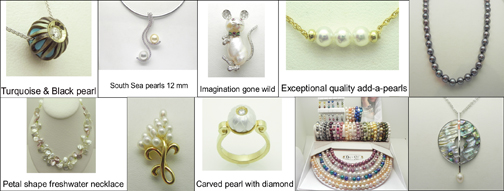Pearls, Beautiful Gems From The Sea. Suitable for Royalty, The Christening of your little Queen, or just for fun!
By Ron Sayers – Graduate
Gemologist (GIA)
Elizabeth, Jackie Kennedy and Princess Diana all wore pearls. Most of today’s modern brides also adorn themselves with pearls. They can be worn on any dressy occasion as well as a semi formal dinner date. Pearls are great with business attire for the professional woman or just out to lunch with the girls.
What is a natural pearl?
Pearls in their natural form are a beautiful accident of nature that is very rare indeed. Natural pearls start from a grain of sand that becomes trapped inside of the Akoya oyster. When the oyster cannot expel the grain of sand it starts to build layers of nacre around it and in time that nacre calcifies and the pearl is formed. The nacre material is the same substance that forms the luster on the inside of the shell of the Japanese Akoya oyster. Our edible oysters and clams can also produce a bead but it in no way has the beauty or luster associated with a fine oriental pearl.
What is a cultured pearl ?
Cultured pearls have the same outward appearance as natural pearls however, the process is started by man inserting a round shell bead in the flesh of the oyster, thus giving the process a head start. From there the oyster secretes the nacre to coat the bead and form the cultured pearl. This process has made beautiful cultured pearl jewelry available and affordable to the masses.
Types of cultured pearls: The most well known and prized for years has been the Japanese saltwater Akoya pearl. The cool water temperatures these pearls are grown in can produce a very high luster pearl up to about 10 mm in diameter.
South Sea and Tahitian pearls on the other hand are cultured in the warmer waters of the South Pacific and Indian Ocean and can produce much larger pearls up to as much as 18 mm in diameter with very good luster but not quite as high as the Japanese Akoya.
Freshwater pearls are another type of cultured pearl that starts with a piece of mantel tissue from another oyster and forms from there. The freshwater pearls therefore have a smaller nucleus than the saltwater cultured pearls. Early freshwater pearls had the appearance of grains of rice however new advancements in recent years have improved the shape and size of freshwater pearls dramatically.
Imitation pearls are glass beads, plastic or any other substance that can be coated or painted to resemble a pearl but are only considered costume jewelry and have very little value and durability.
How pearls are graded:
The factors that determine the value of a pearl are the size of the pearl. Larger pearls are much more rare due to the stress placed upon the oyster to produce them.
The more spherical or totally round the pearl the better and with a strand of pearls the degree to which they match is very important. The finest cultured pearls are at least 95% blemish free and have a very high luster. The color of the pearl is also important as well as the overtone and iridescence, referred to as the orient. The base colors can be pink, white, cream, or green as well as black and yellowish. Many pearls also undergo bleaching and dyeing as part of their preparation for market. Freshwater pearls in particular are dyed in every color of the rainbow to produce interesting fun inexpensive jewelry for all ages.
They said it couldn’t be done:
A recent new twist to pearls was the introduction of a nucleus made of turquoise, amethyst, or citrine quartz which the oyster covered with nacre. The finished cultured pearl was then harvested and carved to expose the inner core of gemstone.
Experts said it couldn’t be done but designer Chi Galatea Huynh proved the experts wrong and gained recent world wide attention with his experiment and new art form.




